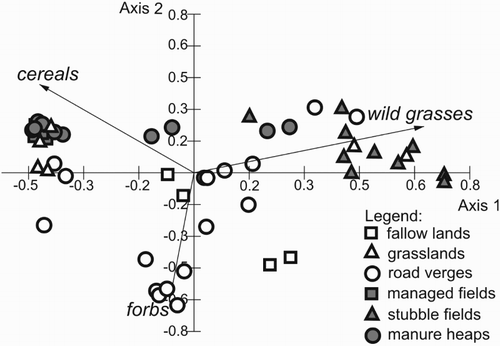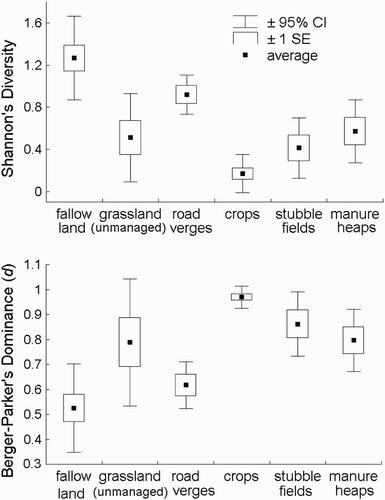Figures & data
Table 1. The general winter diet composition (expressed as percentages) of Yellowhammers E. citrinella on lowland farmland in Poland comprised of semi-natural (crop-free) habitats with permanent vegetation and agricultural habitats; the number of sites is given in brackets; managed fields were autumn-seeded set-aside fields with mustard and one ploughed field; unidentified plant material was probably fragments of seeds of unidentified cereals (59.4% in one sample from fallow land) and Polygonum sp. (52.9% in one sample from a grassy margin).
Figure 1. Winter diet of Yellowhammers E. citrinella expressed as the number (average ± 1 se) of the various plant parts of the three groups of plants (forbs, wild grasses and cereals) in six farmland habitats (a), pooled semi-natural and agricultural habitats (b), dietary components of all grasses (=wild species and cereals) and non-grass species (c) and the proportions of cultivated species (cereals) and wild plants (weeds) (d). A detailed list of identified food items is given in and the Supplemental data.

Figure 2. Results of the PCA analysis of the winter diet composition of Yellowhammers based on the log-transformed abundance of plant fragments of cereals, wild grasses and forbs in six land-cover/farmland habitat types; semi-natural habitats (white); agricultural habitats (black). Eigenvalues: axis 1 – 6.834, axis 2 – 3.449; cumulative percentage variance: axis 1 – 59.1, axis 2 – 89.0. Statistically significant Spearman rank correlation coefficients between the habitat type and axis 1 were found for stubble fields (rs = 0.61, P < 0.001), crops (rs = −0.38, P < 0.01) and manure heaps (rs = −0.31, P < 0.05); and for axis 2 for road verges (rs = −0.52, P < 0.001), manure heaps (rs = 0.48, P < 0.001) and fallow land (rs = −0.29, P < 0.05). Axis 2 also divided all samples into two distinct groups of semi-natural habitats (rs = −0.60, P < 0.001) and agricultural ones (rs = 0.60, P < 0.001).



